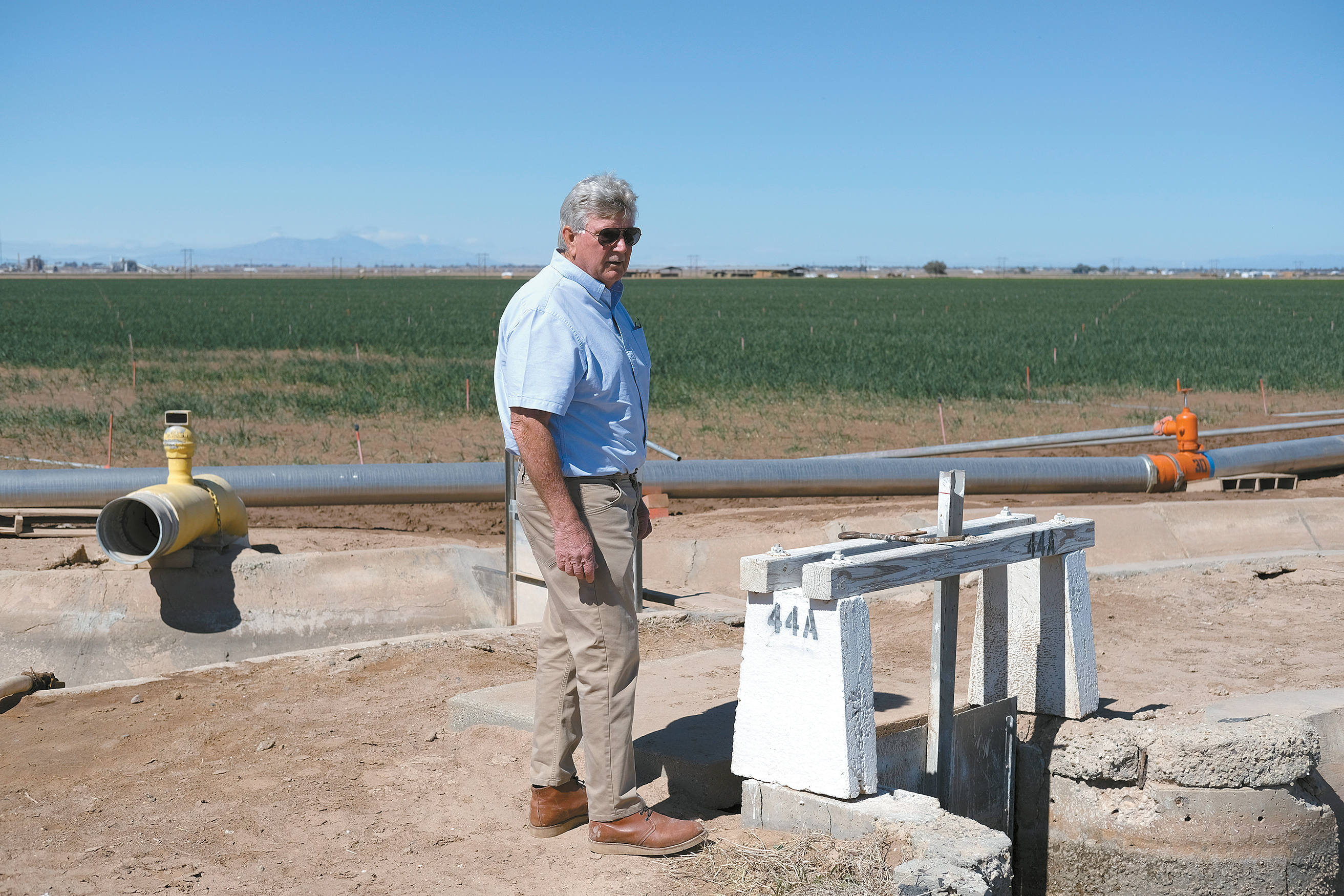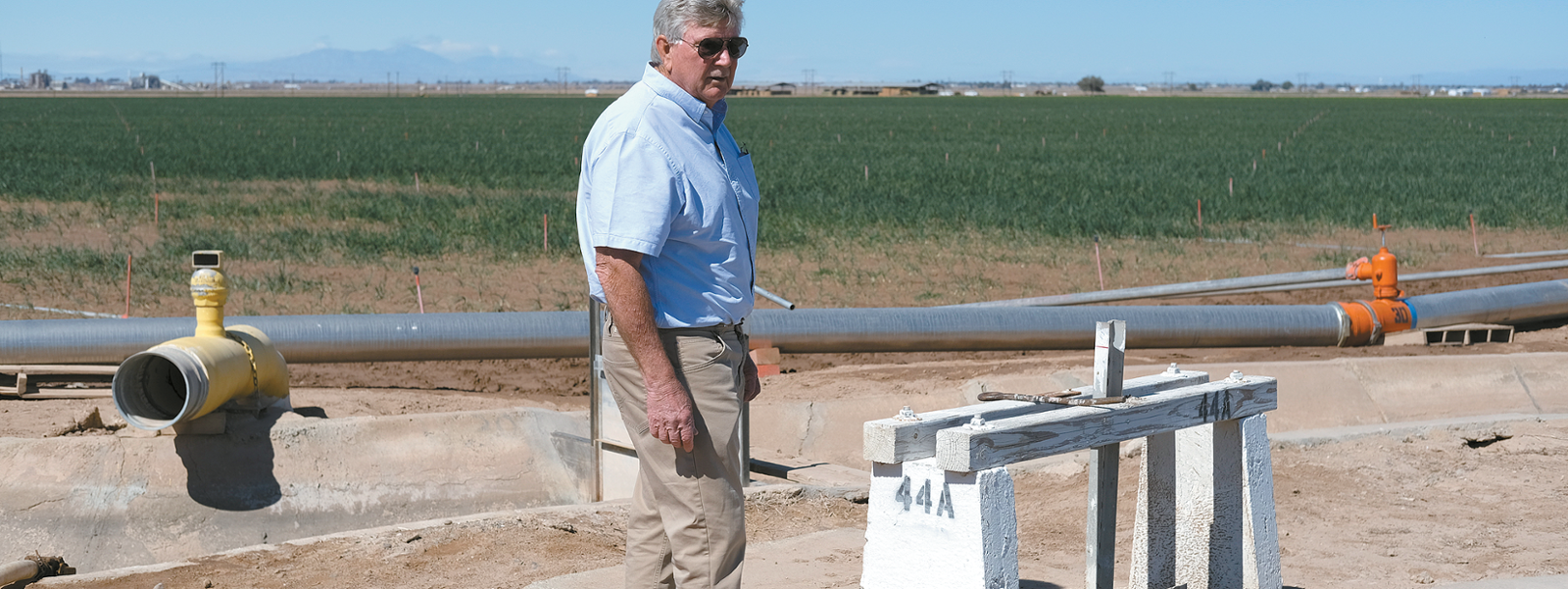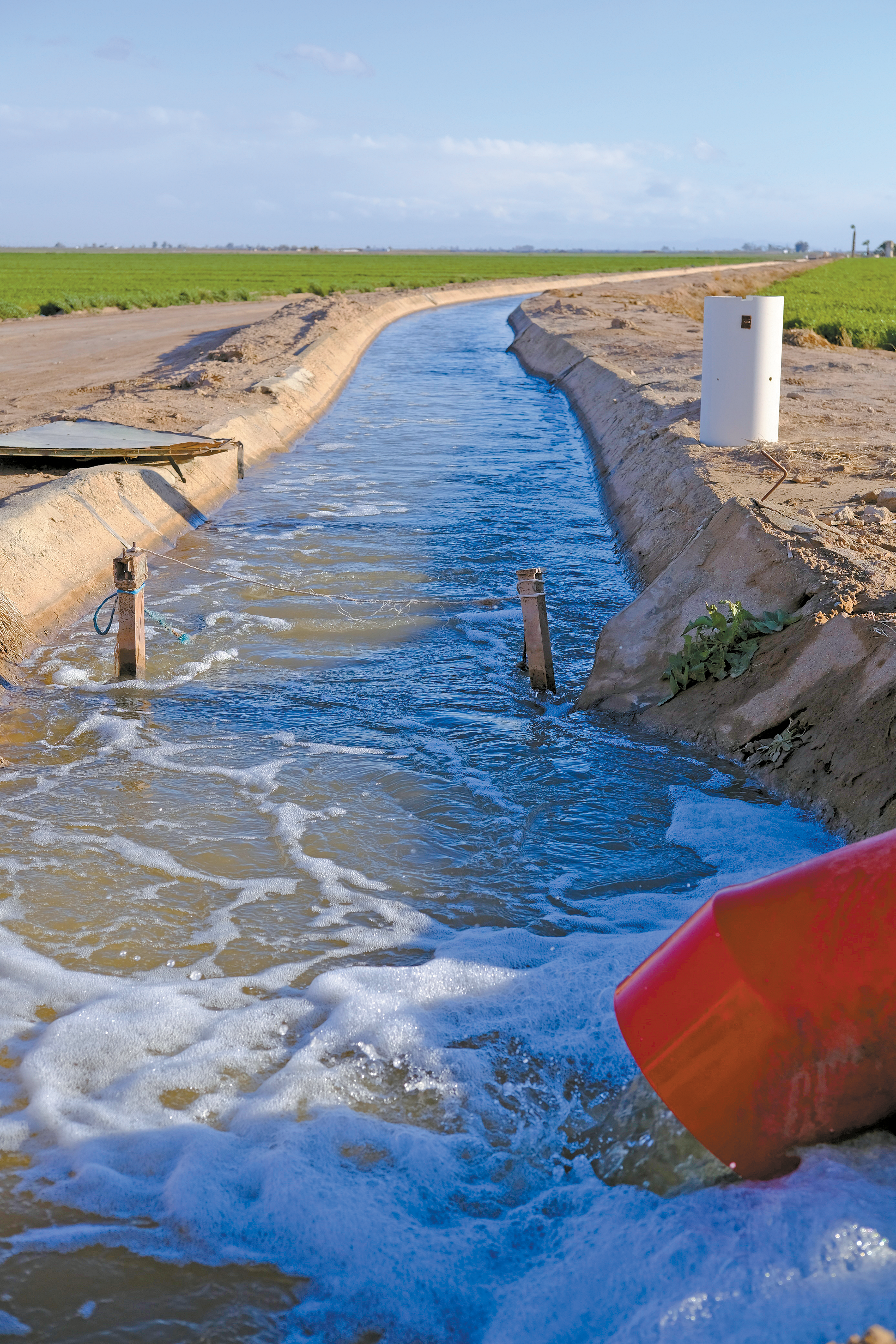Wet year improves Colorado River status

Earlier this year, Imperial Valley farmer Mark Osterkamp stands near an irrigation gate that delivers water from the Colorado River to his fields. Last winter’s historic precipitation has improved conditions on the over-allocated river, according to a new report by the U.S. Bureau of Reclamation.
Photo/Caleb Hampton


Photo/Caleb Hampton
By Caleb Hampton
A consensus plan agreed to last spring by states in the Colorado River’s Lower Basin should keep sufficient water in the river’s key reservoirs for the next three years, according to a report released last week by the federal government.
After decades of drought, scientists had warned that the river, which supplies water to 40 million people in the West and irrigates more than 5 million acres of farmland, was at risk of running dry.
The Biden administration said the plan by California, Arizona and Nevada to conserve 3 million acre-feet of water by 2026 in exchange for $1.2 billion in federal funds should protect the Colorado River system in the short term.
“We have staved off the immediate possibility of the system’s reservoirs from falling to critically low elevations that would threaten water deliveries and power production,” Tommy Beaudreau, deputy secretary of the U.S. Bureau of Reclamation, said in a statement.
Heavy rains earlier this year and a large snowpack in the Rocky Mountains “substantially” improved conditions on the river, according to the more than 700-page environmental impact report.
Despite the improved outlook, implementing the plan will require farmers to voluntarily use much less water over the next three years. In California, most of the water savings will come from farmers in the Imperial Valley, whose water rights entitle them to the largest portion of the river.
“We’re going to be aiming for unprecedented levels of conservation,” said Tina Shields, water manager for the Imperial Irrigation District.
Since 2003, Imperial Valley farmers have used less water than they are allocated, transferring 16% of their entitlement—around 500,000 acre-feet per year—to cities such as San Diego in exchange for funding they must use to build efficient irrigation systems. Under the new plan, Imperial Valley farmers would forfeit another 8% of their water—about 250,000 acre-feet per year—by leaving it in the river.
Under the new programs implemented from next year until 2026, farmers will largely be compensated for water savings through federal funds made available in the Inflation Reduction Act.
With farmers in the Imperial Valley holding some of the most senior water rights on the Colorado River, the irrigation district cannot impose reductions on growers. Water is conserved by establishing voluntary conservation programs, which provide funding in exchange for water savings, and growers make economic decisions on whether to participate.
As of last week, Shields said, IID was still negotiating with federal officials to finalize details of one or more programs, called conservation agreements, that farmers will be able to participate in to conserve water.
“In order to implement a new program, we have to secure the funding, and in order to secure the funding and adopt those programs, we need the environmental coverage and permitting,” she said, referring to the environmental review process that is still underway.
The agencies are aiming to sign off on conservation agreements in time for farmers to incorporate the new programs into their crop plans for next year. Farmers in the Imperial Valley generally make crop decisions between early April and early June and plant most crops in September.
“We have a timeframe we’ve all agreed on,” Shields said. “It’s very accelerated, but it’s very important to all of the participants.”
One potential program to create new water savings would expand on-farm water conservation by giving farmers money to install efficient irrigation infrastructure.
“We would be able to access the federal funding to supplement the budget for those programs and hopefully increase our participation,” Shields said.
More than 70% of Imperial Valley’s farm acreage already participates in the on-farm water conservation program funded through IID’s water transfers to San Diego.
Farmers in the valley said there is still room to expand those efforts.
“If farmers get innovative, we can conserve more and more water,” said Mark Osterkamp, who grows alfalfa, onions, sugar beets and other crops in the Imperial Valley. “I firmly believe that the quicker people build conservation projects, the better off they’ll be.”
Osterkamp has spent years installing water-efficient irrigation systems, such as sprinklers and tail-water return systems that recycle water used to irrigate crops.
“We’re continuing to build new projects,” he said. “We still believe that that’s going to be our savior, if we can conserve a lot of water.”
Another possible program, called deficit irrigation or temporary fallowing, would compensate farmers for leaving their irrigation gates closed in the summer on forage crops such as alfalfa. The program is designed to save water by forfeiting one or two hay cuttings without killing the plant population in those fields.
It is also possible farmers could be paid to fallow some of their acreage, though Shields said IID is trying to avoid that.
“We don’t want to introduce fallowing unless we absolutely have to because of the community impacts,” she said, referring to the many jobs supported by Imperial County’s $2.9 billion agriculture sector.
The water manager said payments to farmers will vary based on the program and likely incentivize growers to keep farming and save water by investing in efficient irrigation systems.
“I would expect the on-farm efficiency-based program to have higher compensation than any sort of deficit irrigation, and obviously fallowing would be the lowest level of funding because that’s not how we prefer to do business down here,” Shields said.
Meanwhile, federal officials released a report earlier this month outlining steps the government will take to develop long-term plans for managing the Colorado River.
By the end of 2024, Reclamation will complete an environmental impact statement draft analyzing the effects of future water use and reductions on the river. The agency will invite public comment on the draft and publish a final statement by the end of 2025.
(Caleb Hampton is an assistant editor of Ag Alert. He may be contacted at champton@cfbf.com.)




